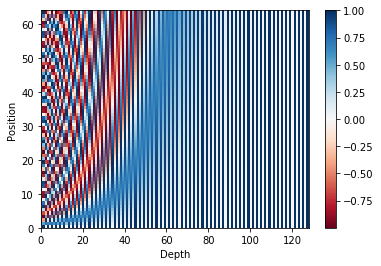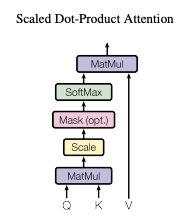이제 코드로도 짜봐야지
목차
읽기 전에
지난 번 트랜스포머(Transformer) 논문 뽀개기에 이어, 코드 레벨로 구현해보았다.
이 포스트를 읽기 전에 아래의 두 포스트를 읽으면 도움이 될 것이다.
참조한 사이트
현청천 님의 블로그에 있는 코드들을 대부분 참고했다.
- Transformer (Attention Is All You Need) 구현하기 (1/3)
- Transformer (Attention Is All You Need) 구현하기 (2/3)
- Transformer (Attention Is All You Need) 구현하기 (3/3)
이 블로그에서 데이터는 Naver 영화리뷰 데이터를 사용해 Binary Classification으로 구현하셨다. 그런데 단순히 똑같이 따라하면 재미가 없으니, 나는 Multi-Label Classification으로 변경하면서, 예외처리를 조금 더 추가하는 방향으로 코드를 구현했다. 또한 모든 코드를 작성한 것이 아닌, 핵심 부분만 작성했으니 전체 코드를 보고 싶으면 위 참조 사이트를 가서 보면 된다.
정말 좋은 글 감사합니다!
트랜스포머 코드 구현
데이터 전처리 부분은 깔끔하게 스킵하겠다. 위 블로그를 접속하면 전처리를 어떻게 진행하는 지 확인할 수 있다.
임베딩
트랜스포머의 임베딩은 Input Embedding과 Positional Encoding 두 가지를 합쳐서 사용한다.

그림을 보면 인코더와 디코더 쪽에 모두 Input Embedding 과 Positional Encoding이 사용된다는 것을 확인할 수 있다.
Input Embedding
임베딩이란?
우리가 쓰는 단어들은 머신러닝 모델에 그대로 주입할 수 없다. 이미 알테지만, 학습을 한다는 것은 행렬과 벡터의 연산으로 가중치를 조절하는 것 이기 때문이다. 그렇기 때문에 입력시키는 무언가(예를 들면 단어, 문장 등 토큰)를 벡터로 변경시켜주는 작업이 필요하다. 이것이 바로 임베딩이다.
Input Embedding은 pytorch 내에서 사용되는 임베딩 함수를 그대로 활용하며, inputs에 대한 embedding 값 input_embs를 구한다.
n_vocab = len(vocab) # vocab count
d_hidn = 128 # hidden size
nn_emb = nn.Embedding(n_vocab, d_hidn) # embedding 객체
input_embs = nn_emb(inputs) # input embedding
print(input_embs.size())
Positional Embedding
트랜스포머는 sequence 순서를 사용하기 위해 토큰의 순서대로 상대적/절대적인 위치에 대한 정보를 반드시 주입해야한다 라고 했다. 그래야지만 단어의 순서를 파악할 수 있고, 정확한 값을 예측해낼 수 있기 때문이다.
이를 계산하는 방법은
\[\text{PE}_{(pos, 2i)} = sin(pos/10000^{2i/d_{model}}) \\ \text{PE}_{(pos, 2i + 1)} = cos(pos/10000^{2i/d_{model}})\]라고 논문에서 설명했으니, 이를 코드로 옮겨보자!
먼저 Position Encoding을 구하는 방법이다.
- 각 포지션 별로 angle 값을 구한다(cal_angle)
- 구해진 angle들 중 짝수 index에는 sin함수를, 홀수 index에는 cos함수를 적용한다.
""" sinusoid position embedding """
def get_sinusoid_encoding_table(n_seq, d_hidn):
def cal_angle(position, i_hidn):
return position / np.power(10000, 2 * (i_hidn // 2) / d_hidn)
def get_posi_angle_vec(position):
return [cal_angle(position, i_hidn) for i_hidn in range(d_hidn)]
sinusoid_table = np.array([get_posi_angle_vec(i_seq) for i_seq in range(n_seq)])
sinusoid_table[:, 0::2] = np.sin(sinusoid_table[:, 0::2]) # even index sin
sinusoid_table[:, 1::2] = np.cos(sinusoid_table[:, 1::2]) # odd index cos
return sinusoid_table
이를 그래프로 나타내면 다음과 같이 나타난다.
n_seq = 64
pos_encoding = get_sinusoid_encoding_table(n_seq, d_hidn)
print (pos_encoding.shape) # 크기 출력
plt.pcolormesh(pos_encoding, cmap='RdBu')
plt.xlabel('Depth')
plt.xlim((0, d_hidn))
plt.ylabel('Position')
plt.colorbar()
plt.show()

그래프에서 보이듯, 각 포지션 별로 다른 값을 갖는다는 것을 확인할 수 있다.
이제 Positional Encoding값을 가지고 Position Embedding 값을 구한다.
- 위에서 구해진 position encodong 값을 이용해 position emgedding을 생성합니다. 학습되는 값이 아니므로 freeze옵션을 True로 설정 합니다.
- 입력 inputs과 동일한 크기를 갖는 positions값을 구합니다.
- input값 중 pad(0)값을 찾습니다.
- positions값중 pad부분은 0으로 변경 합니다.
- positions값에 해당하는 embedding값을 구합니다.
pos_encoding = torch.FloatTensor(pos_encoding)
nn_pos = nn.Embedding.from_pretrained(pos_encoding, freeze=True)
positions = torch.arange(inputs.size(1), device=inputs.device, dtype=inputs.dtype).expand(inputs.size(0), inputs.size(1)).contiguous() + 1
pos_mask = inputs.eq(0)
positions.masked_fill_(pos_mask, 0)
pos_embs = nn_pos(positions) # position embedding
print(inputs)
print(positions)
print(pos_embs.size())
이제 위에서 구한 input_embs와 pos_embs를 더하면 transformer에 입력할 input이 된다.
input_sums = input_embs + pos_embs
스케일드 닷-프로덕트 어텐션

입력값
입력값은 Q(query), K(key), V(value) 그리고 attention mask로 이루어져 있다. 입력값 중 K, V는 같은 값이어야 한다(Q까지 같으면 셀프 어텐션이라고 한다).
계산 순서
계산 순서는 다음과 같습니다.
- K 행렬 전치(transpose)
- Q 와 K 전치행렬 MatMul
- 스케일 조절
- 마스킹(Mask)
- Softmax
- 5번의 결과값과 V를 MatMul
Q = input_sums
K = input_sums
V = input_sums
attn_mask = inputs.eq(0).unsqueeze(1).expand(Q.size(0), Q.size(1), K.size(1))
attn_mask의 값은 pad(0) 부분만 True 입니다.
tensor([[False, False, False, False, False, False, True, True],
[False, False, False, False, False, False, True, True],
[False, False, False, False, False, False, True, True],
[False, False, False, False, False, False, True, True],
[False, False, False, False, False, False, True, True],
[False, False, False, False, False, False, True, True],
[False, False, False, False, False, False, True, True],
[False, False, False, False, False, False, True, True]])
K-transpose and MatMul
앞서 적은 1번과 2번에 대한 코드입니다.
scores = torch.matmul(Q, K.transpose(-1, -2))
스케일
score에 k-dimension에 루트를 취한 값으로 나누는 코드다.
d_head = 64
scores = scores.mul_(1/d_head**0.5)
이 작업을 통해 가중치의 편차를 줄여줍니다.
마스킹
4번에 대한 코드이다.
scores.masked_fill_(attn_mask, -1e9)
print(scores.size())
print(scores[0])
mask를 한 부분이 -1e+9로 매우 작은 값으로 변경된다.
torch.Size([2, 8, 8])
tensor([[ 3.1348e+01, -1.4505e-01, -1.4832e+00, -2.8843e+00, -1.2542e+00, 8.3138e-01, -1.0000e+09, -1.0000e+09],
[-1.4505e-01, 2.7846e+01, 4.9304e+00, 8.7807e-01, 1.5047e+00, 1.6372e+00, -1.0000e+09, -1.0000e+09],
[-1.4832e+00, 4.9304e+00, 2.6831e+01, 3.9618e+00, 2.1587e+00, 3.5587e+00, -1.0000e+09, -1.0000e+09],
[-2.8843e+00, 8.7807e-01, 3.9618e+00, 2.7904e+01, 1.6892e+00, 4.0453e+00, -1.0000e+09, -1.0000e+09],
[-1.2542e+00, 1.5047e+00, 2.1587e+00, 1.6892e+00, 3.2076e+01, 4.0136e+00, -1.0000e+09, -1.0000e+09],
[ 8.3138e-01, 1.6372e+00, 3.5587e+00, 4.0453e+00, 4.0136e+00, 3.8098e+01, -1.0000e+09, -1.0000e+09],
[-5.7174e+00, 5.5846e-01, 3.0447e+00, 4.7429e+00, -1.1263e+00, -2.7216e+00, -1.0000e+09, -1.0000e+09],
[-5.7174e+00, 5.5846e-01, 3.0447e+00, 4.7429e+00, -1.1263e+00, -2.7216e+00, -1.0000e+09, -1.0000e+09]],
grad_fn=<SelectBackward>)
Softmax
5번에 대한 코드다
attn_prob = nn.Softmax(dim=-1)(scores)
이 코드를 통해 가중치가 확률로 변환된다. mask를 한 부분은 모두 0이 된다.
다시 한 번 MatMul
5번 attn_prob와 V를 MatMul하는 코드다.
context = torch.matmul(attn_prob, V)
print(context.size())
이렇게 계산하면 Q와 동일한 shape 값이 구해진다. 이 값은 V값들이 attn_prov의 가중치를 이용해서 더해진 값이다.
torch.Size([2, 8, 128])
차근차근 따라가면 눈에 잘 보일 것이다.
멀티 헤드 어텐션

입력값
Q,K,V,atten_mask는 스케일드 닷-프로덕트 어텐션과 동일하다. head 개수는 2개 head의 dimension은 64다.
Q = input_sums
K = input_sums
V = input_sums
attn_mask = inputs.eq(0).unsqueeze(1).expand(Q.size(0), Q.size(1), K.size(1))
batch_size = Q.size(0)
n_head = 2
계산 순서
계산 순서는 다음과 같습니다.
- Q, K, V를 여러 개의 Head로 나눈다(Multi-Head)
- 앞서 계산한 스케일드 닷-프로덕트 어텐션을 사용한다.
- 2번의 계산을 Concat해서 묶어준다.
- Linear 계산을 해준다.
Multi Head Q,K,V
1번에 대한 계산입니다.
W_Q = nn.Linear(d_hidn, n_head * d_head)
W_K = nn.Linear(d_hidn, n_head * d_head)
W_V = nn.Linear(d_hidn, n_head * d_head)
# (bs, n_head, n_seq, d_head)
q_s = W_Q(Q).view(batch_size, -1, n_head, d_head).transpose(1,2)
# (bs, n_head, n_seq, d_head)
k_s = W_K(K).view(batch_size, -1, n_head, d_head).transpose(1,2)
# (bs, n_head, n_seq, d_head)
v_s = W_V(V).view(batch_size, -1, n_head, d_head).transpose(1,2)
print(q_s.size(), k_s.size(), v_s.size())
Q, K, V ahen Multi Head로 나눠졌습니다.
torch.Size([2, 2, 8, 64]) torch.Size([2, 2, 8, 64]) torch.Size([2, 2, 8, 64])
Attetion Mask도 Multi Head로 변경한다.
attn_mask = attn_mask.unsqueeze(1).repeat(1, n_head, 1, 1)
스케일드 닷-프로덕트 어텐션
위 결과에 스케일드 닷-프로덕트 어텐션을 계산한다.
scaled_dot_attn = ScaledDotProductAttention(d_head)
context, attn_prob = scaled_dot_attn(q_s, k_s, v_s, attn_mask)
Concat
위 결과물을 하나로 묶어주는 Concat 작업을 해준다.
context = context.transpose(1, 2).contiguous().view(batch_size, -1, n_head * d_head)
print(context.size())
Linear
마지막 Linear 작업이다.
linear = nn.Linear(n_head * d_head, d_hidn)
# (bs, n_seq, d_hidn)
output = linear(context)
마스킹된 멀티 헤드 어텐션
마스킹된 멀티 헤드 어텐션은 기존 멀티 헤드 어텐션과 attention mask를 제외한 모든 부분은 동일하다.
""" attention decoder mask """
def get_attn_decoder_mask(seq):
subsequent_mask = torch.ones_like(seq).unsqueeze(-1).expand(seq.size(0), seq.size(1), seq.size(1))
subsequent_mask = subsequent_mask.triu(diagonal=1) # upper triangular part of a matrix(2-D)
return subsequent_mask
Q = input_sums
K = input_sums
V = input_sums
attn_pad_mask = inputs.eq(0).unsqueeze(1).expand(Q.size(0), Q.size(1), K.size(1))
print(attn_pad_mask[1])
attn_dec_mask = get_attn_decoder_mask(inputs)
print(attn_dec_mask[1])
attn_mask = torch.gt((attn_pad_mask + attn_dec_mask), 0)
print(attn_mask[1])
batch_size = Q.size(0)
n_head = 2
멀티 헤드 어텐션
멀티 헤드 어텐션과 동일하므로 위에서 선언한 멀티 헤드 어텐션을 바로 호출한다.
attention = MultiHeadAttention(d_hidn, n_head, d_head)
output, attn_prob = attention(Q, K, V, attn_mask)
print(output.size(), attn_prob.size())
피드포워드 네트워크

- 첫 번째 선형 변환: $f_1 = xW_1 + b_1$
- ReLU: $f_2 = \text{max}(0, f_1)$
- 두 번째 선형 변환: $f_3 = f_2W_2 + b_2$
첫 번째 선형 변환
conv1 = nn.Conv1d(in_channels=d_hidn, out_channels=d_hidn * 4, kernel_size=1)
# (bs, d_hidn * 4, n_seq)
ff_1 = conv1(output.transpose(1, 2))
입력에 비해 hidden dimesion이 4배 커진 것을 확인할 수 있다.
torch.Size([2, 512, 8])
ReLU(or gelu)
원래는 ReLU를 사용하지만 GELU를 사용하는 것이 더 좋다고 알려졌다.
# active = F.relu
active = F.gelu
ff_2 = active(ff_1)
두 번째 선형 변환
conv2 = nn.Conv1d(in_channels=d_hidn * 4, out_channels=d_hidn, kernel_size=1)
ff_3 = conv2(ff_2).transpose(1, 2)
print(ff_3.size())
입력과 동일한 shape으로 변경된다.
torch.Size([2, 8, 128])
Multi-label Classification으로 변경
해당 블로그와 다르게 구현한 부분을 설명하기 위해 이 부분을 따로 뺐다.
단일 라벨에서 다중 라벨을 받을 수 있도록 변경
데이터 셋을 만드는 부분에서 기존 코드는 단순히 라벨을 추가만 해주었다.
self.labels.append(data["label"])
하지만 멀티 라벨에서는 한 문장에 라벨이 여러 개가 붙을 수 있기 때문에 라벨을 원-핫 인코딩해서 넣어주어야 한다.
labels_one_hot = np.zeros(len(APPEAL) - 1, )
label_list = [x.strip() for x in data["label"].split(',')]
for single_label in label_list:
if single_label != "" and single_label != "0":
idx = int(single_label) - 1
labels_one_hot[idx] = 1
self.labels.append(labels_one_hot.tolist())
문장이 인코딩 시퀀스보다 길어서 임베딩 out of index 에러가 발생하는 경우
내가 학습시킨 데이터가 이런 경우에 걸렸다. 이를 방지하기 위해서 문장이 일정 길이보다 길면 잘라내는 코드를 추가했다.
self.sentences.append([vocab.piece_to_id(p) for p in data["doc"]])
이것을
max_len = 256
self.sentences.append([vocab.piece_to_id(p) for p in data["doc"]][:max_len])
으로 변경해주면 된다.
손실함수 변경
기존 단일 라벨 분류에서 쓰는 손실함수를 다중 라벨 분류에 맞게 변경해준다
# criterion = torch.nn.CrossEntropyLoss()
criterion = torch.nn.BCEWithLogitsLoss()
왜 BCEWithLogitsLoss()를 써야하는지 궁금하다면 이 블로그를 참조하면 도움이 된다.
정확도 체크
정확도 또한 계산하는 방식이 달라져야 한다.
""" 모델 epoch 평가 """
def eval_epoch(config, model, data_loader):
matchs = []
model.eval()
threshold = 0
n_word_total = 0
n_correct_total = 0
with tqdm(total=len(data_loader), desc=f"Valid") as pbar:
for i, value in enumerate(data_loader):
labels, enc_inputs, dec_inputs = map(lambda v: v.to(config.device), value)
# 변경 전
# outputs = model(enc_inputs, dec_inputs)
# logits = outputs[0]
# _, indices = logits.max(1)
# match = torch.eq(indices, labels).detach()
# matchs.extend(match.cpu())
# accuracy = np.sum(matchs) / len(matchs) if 0 < len(matchs) else 0
# pbar.update(1)
# pbar.set_postfix_str(f"Acc: {accuracy:.3f}")
# return np.sum(matchs) / len(matchs) if 0 < len(matchs) else 0
# 변경 후
outputs = model(enc_inputs, dec_inputs)
logits = outputs[0]
n_word_total += len(logits)
for i in range(len(logits)):
for j in range(len(logits[i])):
if logits[i][j] >= threshold:
logits[i][j] = 1
else:
logits[i][j] = 0
correct = 0
total = 0
for d, a in zip(logits, labels):
for i in range(len(d)):
if d[i] == a[i]:
correct += 1
total += 1
accuracy = correct / total
pbar.update(1)
pbar.set_postfix_str(f"Acc: {accuracy:.3f}")

![[Python, Pytorch] Attention is All You Need 코드 구현](https://c.wallhere.com/photos/7e/cc/2880x1800_px_movies_optimus_prime_Transformers_Transformers_Age_Of_Extinction-661136.jpg!d)